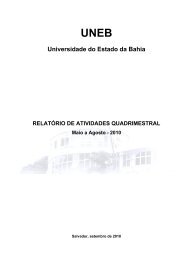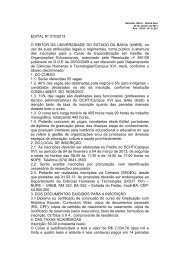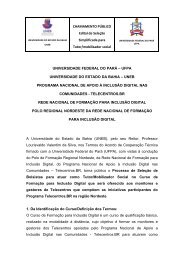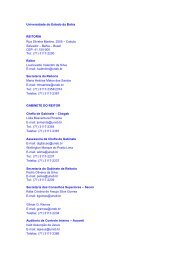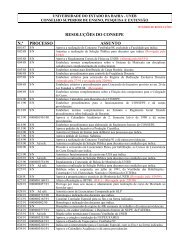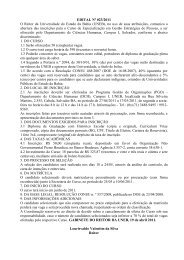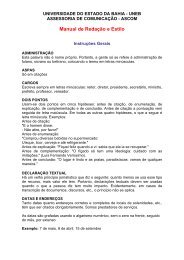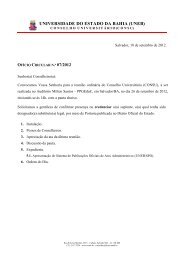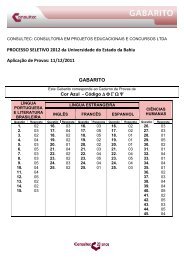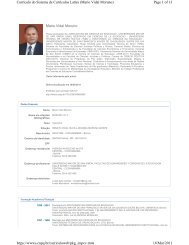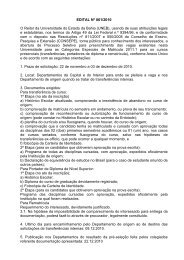Revista da FAEEBA Educação e Contemporaneidade - Uneb
Revista da FAEEBA Educação e Contemporaneidade - Uneb
Revista da FAEEBA Educação e Contemporaneidade - Uneb
Create successful ePaper yourself
Turn your PDF publications into a flip-book with our unique Google optimized e-Paper software.
In search of América: latina/os (re)constructing the U.S.A.<br />
advantage. Marginalized people of color, though,<br />
were largely unable to take advantage of<br />
much of this.<br />
The vision of the U.S.A. as a bubbling caldron,<br />
a “melting pot” where all people blended<br />
and lost their distinctive ethnic characteristics,<br />
had a firm hold on the social imaginary for well<br />
over half of the 20 th century. Accompanying<br />
this metaphor was an almost religious faith in<br />
the American Dream, with the nation seen as a<br />
land of opportunity for all, where hard work<br />
would provide the route to upward mobility. New<br />
immigrants and their descen<strong>da</strong>nts, so the story<br />
went, would progress through hard work up the<br />
social class ladder, marching along a linear path,<br />
abandoning their foreign customs, tongues, and<br />
loyalties, and assimilating into the American<br />
mainstream.<br />
The brunt of the descen<strong>da</strong>nts of the waves<br />
of southern and eastern Europeans who entered<br />
at the turn of the 19 th century did indeed<br />
achieve upward mobility. It was not hard work<br />
alone though that made possible their success<br />
– or explained the failure of populations of color<br />
to rise in the social hierarchy.<br />
Marginality<br />
Descen<strong>da</strong>nts of turn-of-the-century European<br />
immigrants did not experience the enduring<br />
consequences of racialization and racial discrimination<br />
that have long haunted people of color<br />
in the U.S. Like Native Americans, Chinese<br />
Americans, Japanese Americans, and African<br />
Americans, Latina/os endured prejudice, discrimination,<br />
and oftentimes legalized segregation. 11<br />
Chicanos in the Southwest were politically, economically,<br />
and socially marginalized. Puerto Ricans<br />
in the New York area in the 1950s and<br />
1960s found themselves on the economic and<br />
social margins of society, heavily concentrated<br />
in the secon<strong>da</strong>ry labor market and deteriorating<br />
inner cities. Public schools for both populations<br />
were inferior. Like other people of color, they<br />
were essentially excluded from the American<br />
melting pot.<br />
244<br />
The ensuing residential and occupational<br />
segregation they experienced, hand in hand with<br />
the ongoing ethnic revitalization that occurs as<br />
Latina/os maintain connections to their homelands<br />
and newcomers arrive on a regular basis,<br />
enhanced the likelihood of developing a distinct<br />
identity and ethnic soli<strong>da</strong>rity. As Nelson and<br />
Tien<strong>da</strong> note:<br />
(R)esidential and occupational concentration –<br />
are especially crucial to the formation of ethnic<br />
group soli<strong>da</strong>rity in that they produce common<br />
class interests, lifestyles and friendships. When<br />
the ethnic experience includes rejection, discrimination<br />
and oppression, the elaboration of ethnic<br />
ties provides a ready system of support for<br />
groups distinguishable by race, national origin<br />
or language. (1997, p.9)<br />
While the maintenance of identity and language<br />
is understood as a voluntary phenomenon,<br />
and most certainly does have an element<br />
of choice attached to it, it is also a product of a<br />
different reality for Latina/o communities when<br />
compared to the experiences of early 1900s<br />
southern and eastern European immigrants.<br />
Identity may seem a voluntary phenomenon, but<br />
we can also speak of the “structuring” of ethnic<br />
identity 12 .<br />
Despite second-class citizenship, men from<br />
these marginalized groups fought valiantly for<br />
democracy in World War II 13 . What they found<br />
though upon their return, though, was that they<br />
were still denied full citizenship in their own<br />
country. Mexican American soldiers on leave<br />
dressed in zoot suits, for instance, became victims<br />
of mob violence in California while police<br />
stood idly by. A decorated Mexican American<br />
11 It is far beyond my capacity given space limitations to<br />
trace the experiences of these groups in this paper. For an<br />
excellent and succinct insight into U.S. history seen from<br />
the side of the oppressed, see Ronald Takaki’s A Different<br />
Mirror (1993).<br />
12 But at the same time the boun<strong>da</strong>ries are porous, Latina/os<br />
are a diverse lot, and as recent studies substantiate, there<br />
are many ways to “be” Latina/o and to characterize the<br />
Latina/o experience. See for instance García-Colón, 2004.<br />
We must therefore avoid overgeneralizing when trying to<br />
encapsulate “the Latina/o experience.”<br />
13 Soldiers from these groups, including Japanese Americans<br />
whose own families were interned in the U.S. during the war<br />
as potential security threats, were among the most decorated<br />
groups.<br />
<strong>Revista</strong> <strong>da</strong> <strong>FAEEBA</strong> – <strong>Educação</strong> e Contemporanei<strong>da</strong>de, Salvador, v. 15, n. 25, p. 239-257, jan./jun., 2006



